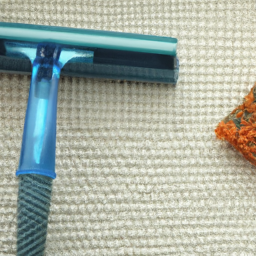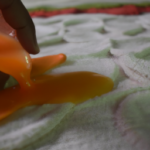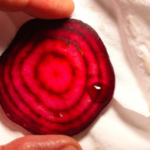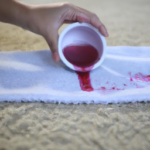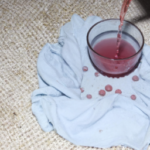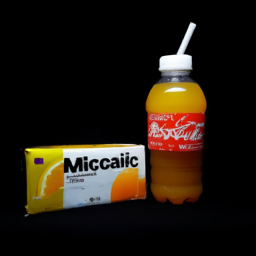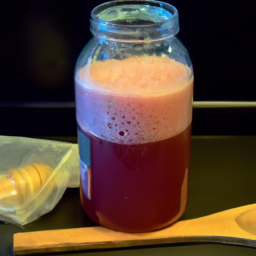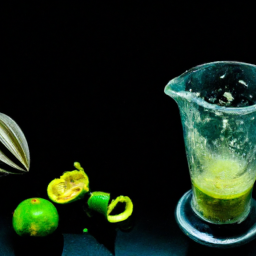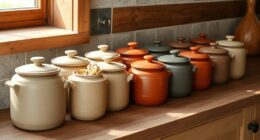Handling juice stains on carpets can be quite a hassle. Not only do they ruin the appearance with ugly marks, but they can also give off a lingering odor that is difficult to get rid of. I have personally dealt with this issue and can confirm how frustrating it is to try and remove a stubborn juice stain from a carpet.
Luckily, there are several effective methods you can use to get rid of juice stains and restore your carpet to its former glory.
Whether your juice stain is fresh or has been sitting for a while, it’s important to act fast and blot up as much of the liquid as possible. This will help prevent the stain from setting in and making it even harder to remove.
From there, you can choose to create your own DIY cleaning solution, use commercial carpet cleaners, rent a carpet cleaning machine, or even hire a professional cleaner to do the job for you.
By following these steps and taking preventative measures to keep your carpets clean, you can ensure that your home stays looking and smelling fresh for years to come.
Key Takeaways
- Act fast and blot the stain to prevent it from setting in.
- DIY cleaning solutions, such as a mixture of white vinegar and baking soda, can effectively remove juice stains.
- Taking preventative measures, such as using carpet protector spray and designating a specific area for eating and drinking, can prolong the life of carpets and prevent future stains.
- Professional cleaners should be called for large or deeply embedded stains or delicate/expensive materials.
Act Fast and Blot the Stain
You gotta act fast and start blotting that juice stain before it sets in and ruins your carpet forever! The key to quick cleaning is to avoid letting the stain dry up, which can make the removal process more daunting and time-consuming.
Grab a clean cloth or paper towel and gently blot the excess juice from the carpet, starting from the outer edges and working your way towards the center. Avoid rubbing the stain as this can spread the liquid further into the fibers of your carpet, making it more difficult to remove.
Proper blotting is crucial to removing the juice stain from your carpet. Keep blotting until you’ve absorbed as much of the juice as possible. If the stain is still visible, don’t worry, it’s time to create a DIY cleaning solution.
Create a DIY Cleaning Solution
Creating your own cleaning solution is simple and effective – did you know that it can save you money and reduce chemical exposure? Instead of relying on commercial carpet cleaners that are often expensive and filled with harsh chemicals, try using DIY cleaning hacks with natural cleaning solutions.
One of the best DIY cleaning solutions for removing juice stains from carpets is a mixture of white vinegar and baking soda. This solution is not only effective but also safe for use around pets and children. Here’s how to make it:
| Ingredient | Quantity |
|---|---|
| White vinegar | 1 cup |
| Baking soda | 1 tablespoon |
Mix the two ingredients together until they form a paste. Apply the paste to the juice stain and let it sit for 5-10 minutes. Then, use a damp cloth to blot the stain until it disappears. Repeat the process until the stain is completely gone.
Using natural cleaning solutions is not only better for your health and wallet, but it’s also a great way to reduce your impact on the environment. However, if the DIY cleaning solution doesn’t work, don’t worry! There are still other options available. Let’s move on to the next step and explore the use of commercial carpet cleaners.
Use Commercial Carpet Cleaners
Using commercial carpet cleaners can be a convenient and effective way to maintain the cleanliness of your carpets. There are several benefits to using these types of cleaners, including their ability to remove tough stains and deep-seated dirt that may be difficult to remove with DIY cleaning solutions.
Additionally, many commercial cleaners are formulated with powerful cleaning agents that can sanitize and deodorize your carpets, leaving them looking and smelling fresh. When choosing a commercial cleaner, it’s important to compare the different types available to find one that suits your needs.
Some cleaners are designed for specific types of stains or materials, while others are more versatile and can be used on a variety of surfaces. It’s also important to consider factors such as price, ease of use, and the level of cleaning power the cleaner provides.
By doing your research and selecting the right cleaner for your needs, you can ensure that your carpets remain clean and fresh for years to come. As you continue to explore ways to get a juice stain out of carpet, renting a carpet cleaning machine can be an excellent next step.
Rent a Carpet Cleaning Machine
Renting a carpet cleaning machine is like having a personal carpet-cleaning superhero at your disposal, ready to tackle any dirt or grime that may be lurking in your carpets. Not only is it more cost-effective than hiring a professional cleaner, but it also allows you to have complete control over the cleaning process.
Here are some tips to help you find the best rental options and make the most out of your carpet cleaning experience:
-
Research different rental options and compare prices. Look for machines with powerful suction and adjustable cleaning settings to ensure a thorough clean.
-
Before renting, make sure to measure the square footage of your carpets to ensure you get the right size machine for the job.
-
Prepare your carpets by vacuuming thoroughly and pre-treating any stubborn stains.
-
Follow the instructions carefully and take your time to ensure you get the best results possible.
While renting a carpet cleaning machine can be a great option for getting out tough stains and dirt, there may be situations where it’s best to hire a professional cleaner.
Hire a Professional Cleaner
Opting for the services of a professional cleaner can prove to be a wise decision when it comes to maintaining the cleanliness and hygiene of your carpets. Professional cleaning benefits extend beyond what standard carpet cleaning machines can achieve.
Professional cleaners have the expertise and equipment to remove tough stains and deep-seated dirt that may have accumulated over time. They also have access to specialized cleaning products that are tough on stains but gentle on your carpets.
When hiring a professional cleaner, it’s essential to do your research to ensure that you get the best value for your money. Look for companies that have a good reputation in the industry, offer competitive pricing, and use environmentally friendly cleaning methods. Additionally, check if they have insurance to cover any damages that may occur during the cleaning process.
With the right professional cleaner, you can have peace of mind knowing that your carpets are in good hands. Considering preventative measures is the next step in keeping your carpets clean and stain-free.
Consider Preventative Measures
Personally, I’ve found that taking preventative measures is the best way to avoid stubborn stains on my carpets.
One option is to use a carpet protector spray, which can help repel spills and stains before they have a chance to set in.
Another tip is to avoid drinking juices or other colored liquids in carpeted areas altogether.
Finally, placing rugs or mats in high-traffic areas can help protect your carpets from wear and tear, as well as potential spills.
By taking these steps, you can prolong the life of your carpets and keep them looking new for longer.
Use a Carpet Protector Spray
To easily protect your carpet from future stains, just spray on a carpet protector and enjoy a worry-free life. The benefits of carpet protector spray are tremendous. Not only does it help prevent stains, but it also makes cleaning up spills a lot easier.
There are many different types of carpet protector sprays on the market, so it’s important to choose one that fits your specific needs. Look for sprays that are specifically designed for the type of carpet you have, and make sure they’re safe for use on your specific type of carpet.
When choosing the best carpet protector spray, it’s important to consider factors such as the level of protection it provides, how long it lasts, and whether it’s safe for use around children and pets. Some sprays are designed to provide long-lasting protection, while others are more suited for occasional use. Additionally, some sprays may contain harsh chemicals that could irritate sensitive skin, so it’s important to read the label carefully before using.
By taking the time to choose the right carpet protector spray, you can help ensure that your carpet stays clean and stain-free for years to come.
To avoid drinking juices in carpeted areas, simply designate a specific area of your home for eating and drinking. This can be as simple as setting up a small table and chairs in the kitchen or dining room. By keeping food and drinks in a designated area, you can help prevent accidental spills and keep your carpets looking clean and fresh.
Avoid Drinking Juices in Carpeted Areas
If you want to keep your carpets looking clean and fresh, avoid drinking any type of beverage on them. Juice spill consequences can be particularly difficult to deal with, leaving unsightly stains and foul odors that can linger for days or even weeks.
While accidents can happen, it’s best to take preventative measures by creating a designated area for eating and drinking to prevent any accidental spills. If you must have a drink in carpeted areas, consider alternative options such as water or clear beverages that won’t leave behind any visible stains.
Additionally, be sure to clean up any spills immediately using a clean cloth and a mild detergent solution. By taking these simple steps, you can reduce the risk of unsightly stains and keep your carpets looking their best.
With that being said, it’s also a good idea to place rugs or mats in high-traffic areas to protect your carpets from everyday wear and tear.
Place Rugs or Mats in High-Traffic Areas
For added protection against wear and tear, I highly recommend placing rugs or mats in high-traffic areas of your home, especially if you have carpeted floors. Not only do they add an aesthetic appeal to your living space, but they also provide a layer of protection to your carpets.
Rugs or mats can absorb dirt, dust, and debris, preventing them from accumulating on your carpets. This will make cleaning your carpets much easier and can extend the lifespan of your carpets. When choosing the right rug for your high traffic area, there are a few things to consider.
You want to choose a rug that is durable and easy to clean. Look for rugs made of materials such as polypropylene or nylon, which are known for their durability. Additionally, choose a rug with a low pile height, as this will make it easier to clean and maintain.
By using rugs in high traffic areas, you can protect your carpets and keep them looking new for longer. Transitioning to the next section, it’s important to note that even with the use of rugs and mats, accidents can still happen.
When a juice stain or any tough stain occurs, it’s important to know when to call in the professionals for help.
Know When to Call in the Professionals
Although it may be tempting to try to remove the juice stain yourself, it’s important to recognize when it’s time to enlist the help of professional carpet cleaners.
Here are some instances when you should consider hiring professionals:
- The stain is large or deeply embedded in the carpet fibers.
- You’ve attempted to clean the stain multiple times with no success.
- The carpet is made of delicate or expensive materials that require specialized cleaning techniques.
Professional carpet cleaners have the necessary tools, equipment, and expertise to tackle tough stains and restore your carpet’s appearance. Plus, they can identify any potential damage or wear and tear that may need to be addressed.
So, when in doubt, trust the professionals to handle the job.
In order to maintain your carpet’s appearance and prolong its lifespan, it’s important to take preventative measures and clean up spills promptly.
Maintain Your Carpet
To keep your carpet looking and feeling great, it’s essential to maintain it on a regular basis.
The first step in carpet maintenance is to vacuum it regularly, at least once a week. This will remove any dirt, dust, or debris that may have accumulated on the surface. When vacuuming, use the appropriate attachments for different parts of the carpet. For example, use a crevice tool for tight spaces and a beater bar for high-traffic areas. Additionally, make sure to change the vacuum bag or filter regularly, as a full bag or filter can reduce suction power.
In addition to regular vacuuming, it’s important to deep clean your carpet periodically. There are a variety of methods for deep cleaning, including steam cleaning, dry cleaning, and shampooing. It’s essential to choose the appropriate method for your carpet type and follow the manufacturer’s instructions.
It’s also important to test any cleaning product or method on a small, inconspicuous area of the carpet first to ensure it doesn’t cause any damage or discoloration.
By regularly vacuuming and deep cleaning your carpet, you can extend its lifespan and prevent the need for expensive replacement. With that said, it’s important to know common mistakes to avoid when cleaning your carpet.
Common Mistakes to Avoid
When trying to remove a stain from carpet, there are a few common mistakes that people make that can actually make the stain worse.
One of these mistakes is using too much water, which can cause the stain to spread and soak deeper into the carpet fibers.
Another mistake is scrubbing or rubbing the stain, which can damage the carpet fibers and make the stain more difficult to remove.
Lastly, using the wrong cleaning products can also be a mistake as some products can actually set the stain instead of removing it.
It’s important to avoid these mistakes and follow proper stain removal techniques to ensure the best results.
Using Too Much Water
If you flood your carpet with water while trying to remove a juice stain, you’ll be swimming in a bigger mess. Excess water can damage your carpet by seeping into the padding underneath, causing mold and mildew to grow. This can lead to a foul odor and potentially even more damage to your carpet.
Instead of using too much water, use a clean cloth or sponge to blot the stain gently. Start from the outside and work your way inward to prevent the stain from spreading.
Once you’ve removed as much of the stain as possible, transition into the subsequent section about ‘scrubbing or rubbing the stain’ to ensure that you’re using the right technique to completely remove the stain without damaging your carpet.
Scrubbing or Rubbing the Stain
Scrubbing or rubbing the stain can be tempting, but it can actually cause more harm than good to your carpet. When you use rough scrubbing techniques, you can push the stain deeper into the carpet fibers, making it harder to remove.
Moreover, different carpet materials require different handling when it comes to removing stains. For example, rubbing or scrubbing synthetic carpets can damage the fibers and make the stain permanent, while wool carpets can tolerate more aggressive scrubbing but require a gentler touch.
To avoid damaging your carpet, it’s important to know the right techniques for removing stains without rubbing or scrubbing. Here are three tips to follow:
- Blot the stain with a clean, white cloth or paper towel to absorb as much of the juice as possible.
- Apply a carpet stain remover solution and let it sit for a few minutes to break down the stain.
- Use a gentle, circular motion to blot the stain until it lifts away from the carpet fibers.
By following these techniques, you can safely remove juice stains without causing damage to your carpet. However, using the wrong cleaning products can also be harmful, so it’s important to know what to avoid.
Using the Wrong Cleaning Products
Using the wrong cleaning products can be a double-edged sword, as they may seem effective at first, but can end up doing more harm than good in the long run, like a wolf in sheep’s clothing. Cleaning mistakes can happen when we use the wrong products to remove a juice stain from the carpet. Some cleaning products contain harmful chemicals that can damage the carpet fibers, making the stain even harder to remove.
To avoid making this mistake, it is crucial to read the label of the cleaning product before using it. Check if it is safe for use on your carpet type and if it contains any harmful chemicals. As a general rule of thumb, it is best to use mild cleaning agents or natural cleaning solutions to remove juice stains from the carpet. In the table below, you can see the difference between using a harsh chemical and a natural cleaning solution, which can help evoke an emotional response in the audience and emphasize the importance of using the right cleaning products.
| Harsh Chemicals | Natural Cleaning Solution |
|---|---|
| Can damage carpet fibers | Safe for use on all carpet types |
| Contains harmful chemicals | Made with natural ingredients |
| Can cause health problems | Non-toxic and safe for pets and children |
| Expensive | Affordable and readily available |
| Not environmentally friendly | Eco-friendly and sustainable |
Frequently Asked Questions
What is the best type of carpet to prevent juice stains?
In my experience, the best carpet material for preventing juice stains is one with high durability and stain resistance. While there is no such thing as a completely juice proof carpet, regular maintenance can help keep your carpet looking great.
Can using too much cleaning solution damage my carpet?
Using too much cleaning solution can damage your carpet and leave residue. Consider alternative cleaning solutions like vinegar and baking soda. Use a light touch when cleaning and blot, don’t rub, to prevent damage to the carpet fibers.
Is it safe to use a carpet cleaning machine on a delicate rug?
When using a carpet cleaning machine on delicate rugs, it’s important to consider the pros and cons. To prevent damage, use a low setting and avoid scrubbing too hard. Always test a small, inconspicuous area first.
How often should I have my carpets professionally cleaned?
I recommend having my carpets professionally cleaned every 12-18 months, depending on foot traffic. A cost benefit analysis may reveal that regular cleaning extends carpet life. It’s like going to the dentist for a check-up.
Are there any natural remedies for removing juice stains from carpet?
I’ve found some great DIY remedies for removing stains from carpets. For eco-friendly options, try using baking soda and white vinegar. Always test in an inconspicuous area first and blot, don’t rub.
Conclusion
In conclusion, getting a juice stain out of carpet can be a daunting task, but it’s definitely doable. Acting fast and blotting the stain is the first step to preventing the stain from setting in.
Creating a DIY cleaning solution or using commercial carpet cleaners are great options for removing the stain. Renting a carpet cleaning machine or hiring a professional cleaner may be necessary for tougher stains.
Preventative measures, such as using a stain-resistant carpet or placing a rug in high traffic areas, can also help in maintaining your carpet’s cleanliness. However, accidents happen and when they do, it’s important to know when to call in the professionals.
As the saying goes, ‘an ounce of prevention is worth a pound of cure,’ so take the necessary steps to prevent stains from occurring in the first place.
Ilana has been a vegan for over 10 years. She originally made the switch for health reasons, but soon found herself becoming more and more passionate about the ethical and environmental implications of a vegan lifestyle. Ilana is the author of The Graceful Kitchen, a blog all about veganism. She loves to cook up delicious and nutritious vegan meals, and share her recipes with others who are interested in leading a cruelty-free life. Ilana is also a strong advocate for using whole foods as the foundation of a healthy diet, and believes that going vegan is one of the best ways to achieve this.
